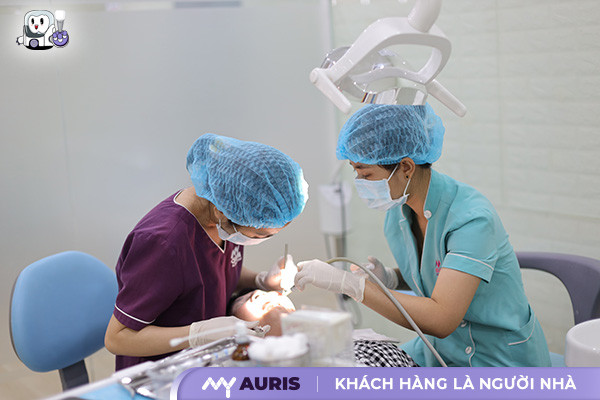Dental implant placement is a modern dental orthopedic method that helps restore lost teeth, providing high aesthetic results and improving chewing ability. However, many people are still worried about whether dental implant placement hurts. This article by My Auris Dental Clinic will help answer your questions!
Does Implant Placement Cause Pain?
When discussing dental implant placement, many people easily imagine the pain caused by drilling or screwing into the jawbone. However, in reality, this procedure is performed much more gently than tooth extraction. Thanks to local anesthesia, patients remain fully conscious throughout the process without feeling pain. In some special cases, general anesthesia may also be used to ensure absolute comfort.
Normally, throughout the implant placement surgery, patients will not experience pain, especially when the gum tissue and jawbone are healthy. If still anxious, the doctor may prescribe additional painkillers or sedatives to provide psychological support to the patient.
The technique itself does not cause pain because the oral area is completely numb before surgery. After placement, some people may feel mild post-implant pain, but the level is insignificant, even less than the pain from tooth extraction. However, if the implant is not placed correctly or if an infection occurs, the pain can be prolonged and more severe.
Currently, implant placement is a popular technique that not only helps restore chewing function but also provides a natural smile, long-lasting teeth, and the feeling of normal eating and daily activities like natural teeth. This is an optimal choice for those who want to regain confidence and a sustainable quality of life.

Factors Affecting Pain Sensation During Implant Placement
Many factors influence this sensation, and understanding them will help you better prepare psychologically and physically.
Dental Anesthesia Technique
Local anesthesia is a crucial step in the dental implant placement procedure. If anesthesia is administered correctly, the patient will not feel pain during the insertion of the implant post into the jawbone. After the anesthetic wears off, a dull ache may appear, but it is usually mild to moderate and can be controlled with common painkillers. Prolonged pain often occurs if the anesthesia or surgical procedure is not optimal.
Tooth Loss Location and Jawbone Condition
The implant location significantly affects the pain level. Implant placement in the lower molars typically causes less pain due to better bone density and fewer nerves compared to the incisor region. Additionally, individuals with healthy jawbones usually recover faster and experience less pain than those with bone loss or who required prior bone grafting.
Number of Implants to Be Placed
The more implants placed, the longer the procedure takes, and the degree of post-procedure soreness tends to increase. In cases of full-arch dental treatment or fixed dentures using multiple implants, patients need to be carefully monitored during the recovery process to limit implant complications and better control pain.
Dentist’s Expertise and Implant Placement Procedure
The dentist’s expertise plays a decisive role in the level of pain. An experienced dentist will perform the dental implant placement procedure correctly and help minimize impact on gum tissue and alveolar bone. Furthermore, modern dental implant systems combined with Cone Beam CT scans assist in precisely locating the ideal position for the implant post, making the placement quicker and less painful.
Type of Implant Post and Artificial Tooth Structure
Dental titanium posts are designed to integrate well biologically with the jawbone. However, if the patient is allergic to metals or chooses an unsuitable type of post, pain may persist longer due to the body’s reaction. Choosing popular implant posts from reputable brands will help limit peri-implantitis or loss of gum sensation after surgery.
Overall Health and Patient Psychology
Individuals in good health and without chronic diseases like diabetes or high blood pressure generally recover faster and experience milder pain. The psychological fear of pain before dental implant placement is also a factor that increases discomfort after surgery. A stable mindset will help the recovery process after implantation proceed more smoothly.
Post-Operative Care Directly Affects Pain Sensation
After direct implantation into the jawbone, patients need to follow post-operative care instructions. Failure to maintain good hygiene can lead to infection causing prolonged pain. Eating properly, taking prescribed medication, avoiding impact to the implant area, and attending regular check-ups are ways to reduce the risk of tooth pain and increase the chances of the implant’s permanent survival.
How to Effectively Reduce Pain After Dental Implant Placement?
Pain after dental implant placement is a common concern. However, by understanding the causes and knowing how to manage them correctly, most patients can effectively control the pain sensation. Here are practical guidelines to help you significantly reduce pain after dental implant placement:

Using Painkillers at the Correct Dosage and Time
Immediately after surgery, the dentist will prescribe painkillers and anti-inflammatory medication. You need to take the correct dose at the right time, even if you don’t feel significant pain yet. Consistent use helps prevent pain from flaring up after the anesthetic wears off. Do not arbitrarily increase or skip doses as this can affect the liver, kidneys, and gum tissue recovery process.
- If you experience significant pain within the first 48 hours, non-steroidal anti-inflammatory drugs (NSAIDs) can be used as directed by your doctor.
- Absolutely do not use strong painkillers like opioids unless prescribed.

Applying Cold Compress Correctly During the First 24–48 Hours
Applying a cold compress to the outer cheek area at the implant site within the first 24 hours helps constrict blood vessels, reduce swelling, and limit radiating pain. Apply for about 15–20 minutes each time, with a 1-hour interval.
- Use a specialized cold pack or ice wrapped in a thin cloth.
- Avoid applying ice directly to the skin as it can cause frostbite.

Eat Appropriately to Avoid Damage to the Implant Area
Eating habits directly affect the recovery process and pain sensation. You should: Eat soft, cool, easy-to-swallow foods for the first 3 days. Avoid chewing on the side with the implant for at least 7 days. Do not consume spicy, hard, or hot foods as they will irritate the gum tissue and the jawbone integrating the implant.
Maintain Careful Oral Hygiene Without Strong Impact
It is necessary to clean your mouth after each meal to prevent bacterial invasion. However: do not use toothpicks or dental floss near the newly implanted site. Use a super soft-bristled toothbrush and alcohol-free mouthwash. After 3–5 days, you may gently use a water flosser for a more thorough cleaning.
Follow Up Appointments as Scheduled for Timely Check-ups and Treatment
After dental implant placement, you need to return to the dental clinic for scheduled appointments. The dentist will check the implant post, gum tissue, and bone integration. If there are unusual pain symptoms such as sharp pain, pus, loss of gum sensation, etc., these could be signs of complications like peri-implantitis, requiring early treatment.
Maintain a Comfortable Mindset, Avoid Prolonged Anxiety
Feelings of anxiety and stress can make you perceive pain more acutely. A stable mindset is an important factor in overcoming the post-operative period. You can listen to soft music, meditate, or simply rest more during the initial days.
How Long Does Pain Last After Dental Implant Placement?
Typically, pain after implant placement lasts approximately 3 to 7 days. After 2 weeks, most patients have fully recovered soft tissue and no longer feel discomfort. If the dental implant placement procedure is performed with correct technique, effective local anesthesia, and the patient adheres to post-operative care, healing occurs quickly and safely.
Initial Phase: 24 to 72 Hours After Implant Placement
During the first 24 hours, the dentist usually prescribes painkillers, combined with cold compresses on the outer cheek to reduce swelling. This stage is crucial; strenuous activity should be limited, and soft foods should be eaten, avoiding any impact on the implant area.
By the second or third day, the pain sensation will gradually decrease. Many patients describe the feeling as similar to post-tooth extraction or deep cavity filling. For individuals with good physical constitution and quick implant-to-bone integration, they feel more comfortable after just 3 days.
Recovery Phase: From Day 4 to 14
From day 4 onwards, with proper care, the pain sensation almost disappears. At this time, the gum tissue is gradually stabilizing around the dental titanium post, and the process of biological integration with the jawbone begins.
This stage is also when the dentist conducts follow-up appointments, checking the healing status of the gum tissue and evaluating the implant post’s integration. If no implant complications occur, the patient can begin to resume near-normal activities.
Complete Stabilization Phase: From Week 3 to Month 3
From week 3 onwards, the implant site will almost no longer feel toothache. The implant post has become relatively stable in the alveolar bone, and the patient begins the phase of fixed prosthetic restoration.
Within approximately 6 to 12 weeks, most implant posts will complete the osseointegration process with the jawbone. This period can be shorter if the jawbone is healthy, or longer if bone grafting is required, or if the missing tooth area is a high-stress area like the lower molars.
Should You Be Worried About Pain During Dental Implant Placement?
In reality, most patients rate the pain during implant placement as not as severe as imagined. Thanks to the application of local anesthesia, patients feel no pain at all during the procedure. Some dental clinics even combine advanced anesthetic techniques to better control sensation, even for sensitive individuals.
Anxiety is a natural reaction, but you shouldn’t let the fear of pain prevent you from restoring chewing function and oral aesthetics. Modern dental implant systems are precisely designed, capable of biological integration with the bone, and maintain long-term stability without affecting adjacent teeth.
If you have ever had a wisdom tooth extracted, a dental crown, or even braces, dental implant placement will not cause more pain. The most important thing is to choose an implant dentist with expertise and a reputable facility to ensure that the high-precision technique is performed according to the correct procedure.
With a clear treatment plan, accurate assessment of gum tissue, alveolar bone, and tooth loss location, combined with precise dental anesthesia, you can completely rest assured that the direct implant placement into the jawbone will be a gentle process.





